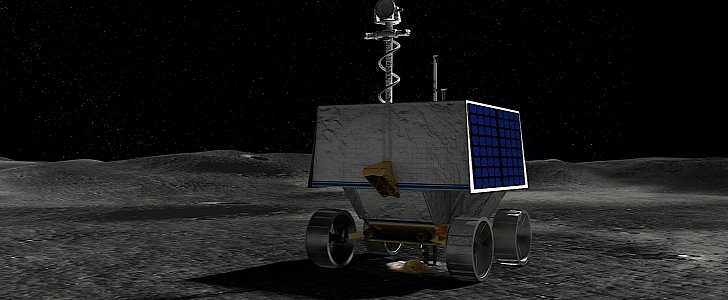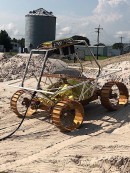If there was any doubt NASA is taking the new exploration program seriously, then this might chase those doubts away: in 2020, NASA will begin the first resource-mapping mission on the surface of another world.
More precisely, the space agency will be sending a water hunting mission to the Moon’s South Pole. The main tool used to do this is a rover called Viper. That’s the cool acronym for the not so cool full name of the machine: Volatiles Investigating Polar Exploration Rover.
The rover is about the size of a golf cart and it is fitted with four scientific instruments, including a 1-meter drill that would be used to sample lunar soil looking for traces of water. As it happens, the place where Viper will be conducting the mission is the same one where NASA’s astronauts are scheduled to land in 2024.
“As the first resource-mapping mission on the surface of another world, VIPER will help pave the way for a new era of human missions to the lunar surface and will bring NASA a step closer to developing a sustainable, long-term robotic and human presence on the Moon as part of the Artemis program,” the agency said in a statement.
What the agency is actually talking about is in-situ resource utilization. That means that for a constant human presence on another celestial body, at least part of the resources needed for their survival must be found and exploited on location.
On Wednesday, June 10 2020, NASA will be announcing the company tasked with taking the Viper rover to its workplace. That’s because the mission is part of the Commercial Lunar Payload Services program, an offshoot of the Commercial Crew Program that just managed to send two men to the International Space Station.
Over the past few years, NASA has been using private companies for its missions as a means to cut development cost and speed up the Artemis Moon exploration program.
The rover is about the size of a golf cart and it is fitted with four scientific instruments, including a 1-meter drill that would be used to sample lunar soil looking for traces of water. As it happens, the place where Viper will be conducting the mission is the same one where NASA’s astronauts are scheduled to land in 2024.
“As the first resource-mapping mission on the surface of another world, VIPER will help pave the way for a new era of human missions to the lunar surface and will bring NASA a step closer to developing a sustainable, long-term robotic and human presence on the Moon as part of the Artemis program,” the agency said in a statement.
What the agency is actually talking about is in-situ resource utilization. That means that for a constant human presence on another celestial body, at least part of the resources needed for their survival must be found and exploited on location.
On Wednesday, June 10 2020, NASA will be announcing the company tasked with taking the Viper rover to its workplace. That’s because the mission is part of the Commercial Lunar Payload Services program, an offshoot of the Commercial Crew Program that just managed to send two men to the International Space Station.
Over the past few years, NASA has been using private companies for its missions as a means to cut development cost and speed up the Artemis Moon exploration program.



